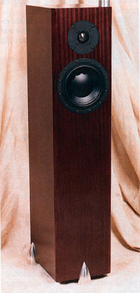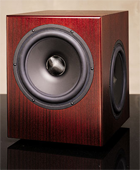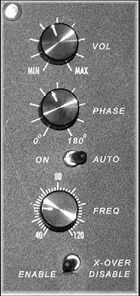Totem Thunder

Early this year, I reconfigured the video setup, among other things adding a little Velodyne “MiniVee” subwoofer that worked really well, but made me think that perhaps the big Serious Music system could benefit from subwoofer love. So I added a Totem Thunder; herewith an unashamedly sicko-audiophile (but quantitative, with measurements) fragment that obsesses about music in general and Really Low Frequencies in particular; with a side-trip to a church in Paris. I’ll provide some introductory material in hopes of maybe luring innocent readers into this obsessive and expensive hobby.
Cause and Effect · It became apparent to me that the new subwoofer in the TV system (a cute little thing, no more than a foot in any dimension) was playing some notes that were lower than the big pure-audio system in another part of the house could go. Once I heard them, this was unacceptable.
Leaping ahead to the conclusion: With the Thunder in place, the big system can go lower, which is nice, although there really isn’t that much music that reaches that low-most people have never actually heard a musical note much below 40Hz. But the good news is that the subwoofer helps out the whole system; I can hear it and I measured it just to be sure; read on.

History · My main speakers, for the last four years or so, have been a pair of Totem Acoustic Forest floor-standers. Although the system has changed a bit over the years, I’ve only ever had Totem speakers in it since about 1990. I heard the original Totem Model One at an audio show in Toronto many many years ago, playing some Purcell string suite, and fell instantly in love. I’d still be using the Model Ones except for our living room is large-ish, and when I played big orchestral pieces at high volume (much harder on the system than most rock & roll), things were sounding kind of stressed. I basically wanted the same sound, but more of it; thus the Forests.
I could go on about the sound of the Forests, but I think I’ll outsource that; have a look at the extended discussion of the speaker from Stereophile, one of the Big Two audiophile magazines. I think that piece is a good introduction to audiophile culture. First, Larry Greenhill goes on for some pages, discussing various aspects of the speakers’ sound as illustrated by specific musical recordings; praising some things and criticizing others. Then, John Atkinson runs some careful quantitative tests on the speaker, producing a couple of graph-laden pages.
Both these parts are from 2001. Then, there’s a follow-up piece by Atkinson from 2005; no more tests, just listening.
The conclusion is consistent; the Forest listens and measures well, but the bass extension is kind of limited. Atkinson reports that filling the bottom of the speaker with sand (it has a compartment for this purpose) really improves things.
High-End Business Practices · So I sent an email to the contact address on the Totem website, wondering what they’d suggest; I got a “we’re on vacation, next week” auto-reply, and sure enough, they responded the next Monday, recommending their Thunder and Storm subwoofers as good matches for the Forests, and attached a list of the local dealers.

I was so impressed by the little Velodyne I’d bought that I was going to check their products out too, but what happened was, I was on another errand that took me by one of the dealers and so I stopped in. The dealer looked like they weren’t doing that well, the place was a bit run-down and disorganized. When I mentioned that I was thinking about the Totem subwoofers, the guy pointed me at a floor model of the Thunder, in apparently perfect condition, and offered me a terrific deal—I’d checked prices so I knew. Anyhow, I ended up taking it home, albeit without the original packaging or manual (yes, the dealer was hurting I think).
So when I got home I emailed Totem and asked if they had an electronic version of the manual, and there was a Word document in my in-basket a couple of hours later, along with notes on how they recommended setting up the Thunder to work with the Forests. The manual revealed that the Thunder was supposed to come with feet, only mine hadn’t. I mentioned this in my thank-you note to Totem and went downtown to shout at the dealer, who couldn’t find them, but said they’d see what they could do.
By the time I got home there was another email from Totem saying the dealer had contacted them about me, what was my address, they’d just send some new feet along. Is that service or what? The high end is like that.
The Sound · Of course, I had to start with low-bass showpieces, of which there aren’t that many. The bottom string on a bass guitar or fiddle is 42Hz, which is pretty darn low, and there’s really not that much music that goes south of there. One exception is Enya; the opening title track from her 1988 Watermark album has some very low synthesizer, and track 10, The Longships, has the most musically intelligent ultralow sounds I’ve ever heard, monstrous strokes on a huge bass drum, they shudder the air and are still sweetly melodic. If you’ve heard this song on ordinary speakers, they just omit the big drum and it still sounds OK, but the whole song falls into place, musically, once the foundation is there.
A Church in Paris · My other showpiece is The Great Organ of St. Eustache, (Dorian 053479013422, 1993), featuring Jean Guillou. By the way, if you’re a music lover and find yourself in Paris on any Sunday, do yourself a favor and visit Saint Eustache, right in the middle of town, it’s a nice church and the organ is one of the world’s greatest, and there’s regularly free music to listen to.
That organ is by Van den Heuvel, and it has its own website, check it out, really. The titular organist is Jean Guillou, and I’m a big fan; he’s done lots of recordings, some on much smaller instruments, and he’s got lots of nuance and grace. But when he points the big iron at a meaty piece of Bach or Liszt or Franck, it feels like someone’s reaching in and squeezing your pancreas, in a nice sort of way.
On that Dorian recording, some of the music is more interesting than others (Guillou is a better performer than composer) but my favorite is Liszt’s Fantasy and Fugue on the Name B-A-C-H. Crank this up on a good system and it’s real easy to frighten yourself. The Saint-Eustache organ has three different 32' bass stops and you really can’t begin to imagine what it sounds like there in the church. The Thunder takes you a small part of the way there, and even that’s pretty mind-boggling.
Thrilling the Kid · I was home alone with the six-year-old when I was setting up the Thunder, so I called him over and said “listen to this” and played the Enya and Liszt tracks. He literally jumped up and down with glee, grinning from ear to ear. I’ll make an audiophile of the boy yet.
Ordinary Music · Just like the little Velodyne, the Thunder has a circuit that turns it on automatically a few seconds after music starts playing. I noticed that when it kicked in, the low bass didn’t change very much, but the whole thing sounded... better.
I haven’t figured it out yet, but something good is happening. To start with, I think that even though the sub is being rolled off about 60Hz, it’s filling in enough sound that both the main amplifier and the Forests are working less hard and running a little easier. Also, as I said, it’s a biggish room, and maybe there’s some synergy there. Anyhow, the net effect is that I’ve been sitting up late recently, listening to one piece of music after another, without really thinking much about frequency ranges. Some disks that have sounded particularly excellent on recent evenings are the James Gang’s Rides Again (on LP), Miles Davis’ Ascenseur Pour L'Echafaud, and Rickie Lee Jones’ Pop Pop. That last one has some surprising string-bass parts; the other two have nothing special in the low notes, but they still sound better, go figure.
I love this hobby; you get to geek out and buy beautiful objects, and the reward is music.
Measuring · I may be a deranged audiophile but I’m also an engineer dammit, so I decided to break out the measuring gear, which in this case is a basic Radio Shack SPL meter, they’re under $50 and are remarkably accurate for the money. The ones they sell now have a digital readout, but mine is ten years old and has a funky analogue needle that’s fun to watch.
It turns out that you can get test CDs to help with this. The one I use is from Stereophile, yes, the magazine, and it has some first-rate music on it along with the test tracks. Among the test tracks are 30 or so “warble-tone” tracks that cover the whole audible spectrum, from 20Hz to 20KHz. (Both those extremes are kind of nominal, you can’t actually hear 20Hz so much as feel a rumble in your chest, and my middle-aged ears only go up to about 15KHz). So what you do is you put the SPL-meter on a camera tripod at the listening position, play the first warble tone and fiddle with the volume and sensitivity to get it at zero dB, then run through all the warble tones and watch the needle.

With the Thunder in the system, after I’d fine-tuned its level control based on a couple of runs, the measurements were outstanding. At the listening position, it was very flat from 1000Hz down to 31Hz, typically ±2dB, with one or two little excursions to ±3. 20Hz was at -6dB, and then the high frequencies, from 1000Hz or so up to the top, were evenly depressed, -4dB to -6dB all the way across. These are very good numbers for a home-audio in-room real-world scenario.
Velodyne? · The Thunder’s controls are illustrated there to your right, and are pretty easy to figure out. They’re remarkably like the those on the MiniVee in the video system.
The Thunder has a circuit just like the Velodyne’s where it detects a signal and wakes from sleep. There’s this clever blue LED on the back where you can’t see it, and when the Thunder wakes up it projects an elegant small soft blue circle on the wall behind it. The MiniVee has a blue LED on the front for this same purpose, the exact same colour.
Both subs sometimes require that you briefly crank the volume a little higher than you might like it, to wake them up. The amount of crankage required “feels” really similar, like exactly the same. Both stay on for a few minutes after the music stops, so you usually only have to do this once per evening.
So I suspect that the Thunder actually includes some Velodyne technology. The cabinetry is distinctively Totem, and I assume they’ve done some work on the drivers. This wouldn’t be surprising, there’s lots of rebranding and rebadging that goes on in the high-end world. Among other things, a subwoofer has to include an amplifier, and Totem doesn’t make those—their core competence is drivers and cabinets—so it would make sense for them to have outsourced that.
Smiles · Anyhow, this has been a successful little project; if you’re a music lover, consider giving audiophilia a try. It’s less expensive than gambling, substance abuse, or philandering, and should thus rank pretty low among the vices. Now I’m wondering where to go to get sand and lead shot, suitable for ballasting the Forests. I’ll report on how it goes.